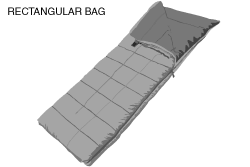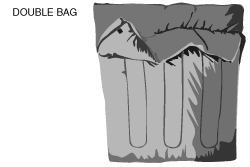Sleeping Bags
Sleep comfortably and securely knowing you bought the right sleeping bag for the conditions and mode of travel.
How To Buy A Sleeping Bag
A good sleeping bag, or lack thereof, can make or break a camping trip. There are plenty of models out there to choose from, in a variety of lengths, shapes and fills. Choosing the right bag depends on your sleeping habits, the temperature and climate where you intend to camp, and whether you'll be carrying the bag in a backpack, boat or car. Use the guidelines below to help you select the sleeping bag to meet your needs.
Intended use
How do you plan to use your sleeping bag?
- Wet or dry environment
- If there is a good chance of rain, look for a water-proof or water-resistant bag
- In a tent, cabin or RV
- Cabin or RV camping allows you to purchase a slightly heavier bag since you won't be lugging it around
- In warm, cold or moderate temperatures
- Pay attention to manufacturer temperature ratings
- Buy for the coldest temperature you might face, but don't overdo it
Temperature rating
There is no universal standard for rating sleeping bags. Ratings vary according to manufacturer. How a bag performs greatly depends on its insulating material, construction and loft. When selecting a temperature rating for a sleeping bag, be sure to consider the following:
- The lower the rating, the warmer the bag
- If you plan to camp in warm conditions and also want your bag to be comfortable on cool spring and fall nights, look for a three-season bag rated to 20 degrees
- Traditional camp bags are comfortable to about 40 degrees
- In general, consider the coldest night you will likely experience, and then drop down 10 or 20 degrees
- Keep in mind that temperature ratings always assume that the bag will be used with a ground pad
- The loft of a sleeping bag refers to how much the insulation "fluffs up"
- More loft means more warmth
- For maximum loft, look for a bag with a differential cut, one in which the inner lining is smaller than the outer shell. This allows the insulation to loft up to its maximum.
Fill/Insulation
Most sleeping bags are filled with goose or duck down or with synthetic insulation. These materials are sandwiched between the sleeping bag's shell and lining via enclosed channels, layers or baffles.
Down
- Light and compressible
- The best natural insulator, with a higher weight-to-warmth ratio than any synthetic on the market
- The preferred choice for those who want to travel light in dry conditions
- This insulation is more expensive than synthetic fills, and loses most of its insulating capacity when wet, plus it takes a long time to dry
- Note that each down bag has a fill power number that indicates how much space an ounce of down will fill. The higher the power, the loftier and warmer the bag.
Synthetic
- Usually less expensive than down fills
- Higher end synthetic fills come close to down's efficiency
- Because synthetic insulations work when wet, and also dry quickly, they are ideal for boating trips and for camping in wet conditions
- They also weigh more than down and take up more space when packed
- Among the most frequently used synthetic fills are Duofill and Hollofil
Shapes and sizes
Sleeping bags come in various shapes and sizes and should be bought according to body type, sleep habits and environment.
Shape

Mummy bags
- Cut wider at the shoulders and taper down to the feet
- This shape is considered the most efficient for weight and warmth

Rectangular bags
- More comfortable for those who tend to toss and turn
- Not as warm because the large top opening is more conducive to heat loss
Semi-rectangular bags
- Provide some extra room and warmth
- They have a tapered foot, contoured hood, and additional room in the torso for comfort
- Good compromise between the other two shapes

Double bags
- Rectangular in shape and will accommodate two people
- Some models can be zipped apart and used as two separate bags
- Some double bags also have more insulation on one side, so that on colder nights, the heavier side can be used on top for extra warmth and insulation
- In general, these bags are most suitable for cabin and casual family camping use
Size
- Choose a bag that's big enough for comfort but not so big as to add weight, or create an abundance of dead space that is hard to keep warm
- A bag that is too small will cause the insulation to become too compressed to work efficiently
- There are also women's-specific bags to consider
- Check each manufacturer to determine whether "women's" means a shorter men's bag, or whether the cut and insulation are indeed female-specific
- Women's bags are typically cut wider through the hip and torso area, come in shorter lengths, and have extra insulation in the foot and midsection
Shells
- There are a variety of outer layer shell materials available
- Most shells are made of polyester or nylon microfiber that is tightly woven, light and, to varying degrees, water- and wind-resistant
- Ripstop is also popular because of its durability. The higher the thread count, the better the wind- and water-resistance.
Other features
Lining
- Most high-end bags have a nylon taffeta lining
- Non-technical camp bags usually have a polyester cotton lining
- Fleece liners are for those looking for extra softness and warmth
Zipper
- A two-way zipper affords better ventilation and flexibility
- If you want to zip two bags together, be sure to look for the appropriate left- and right-side configurations
Draft collar
- Located at the base of the hood
- Prevents heat loss from around the neck and shoulders
Accessory pockets
- While these can sometimes come in handy, be sure to check their position and padding
- If your head requires extra cushioning, some bags feature extra padding in the hood
- Better yet is a fleece-lined stuff sack that can be turned inside-out and filled with extra clothes to make a pillow
- If cold feet are a problem, look for a bag that has extra insulation in the foot area (typically found in high-end women's-specific bags)